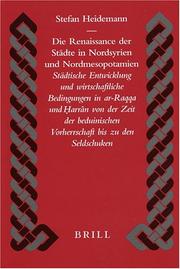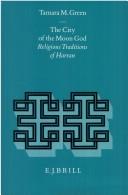| Listing 1 - 3 of 3 |
Sort by
|
Book
Year: 1901 Publisher: Leipzig : Hinrichs,
Abstract | Keywords | Export | Availability | Bookmark
 Loading...
Loading...Choose an application
- Reference Manager
- EndNote
- RefWorks (Direct export to RefWorks)
Cuneiform inscriptions, Akkadian. --- Akkadian language --- Texts. --- Assyria --- Harran (Turkey) --- History --- Sources. --- Antiquities.

ISBN: 9789004122741 9004122745 9789004492240 9004492240 Year: 2002 Publisher: Leiden Brill
Abstract | Keywords | Export | Availability | Bookmark
 Loading...
Loading...Choose an application
- Reference Manager
- EndNote
- RefWorks (Direct export to RefWorks)
The period between 950 and 1150 A.D. is regarded as "turning point in the history of the Islamic Culture" from the Early Islamic to the Late Medieval civilization. What led to the urban decline in between and the later recovery? Ḥ̣arrān and al-Raqqa serve as paradigma for the development in Northern Syria and Northern Mesopotamia. The collapse of the ʿAbbasid state left the region cornered between Buyids, Fatimids and Byzantines to the nomadic tribes not acquainted with urban culture. After 1086 A.D., measures undertaken by the Seljuqs in order to safeguard their hegemony led to a renaissance of cities inspite of permanent power struggles and the crusades. They based their rule on fortified places. The financing of the army led to the distribution of land as fiefs ( iqtaʿ ) and subsequently to a dislodgement of nomads and a recultivation of former agricultural land. Cash money for the treasury was generated by skimming long distance trade; this in turn required public security on the roads. An analysis of the monetary circulation according to archaeological and literal evidence serves as measure for the economic recovery. A corpus of the coin production in al-Raqqa, ḥarrān and al-Ruha'/Edessa supplements the textual sources.
Seljuks --- -Salājiqah --- Saljuks --- Oghuz (Turkic people) --- History --- -Harran (Turkey) --- -Raqqah (Syria : Province) --- -Economic conditions --- -Seljuks --- -History --- Salājiqah --- Harran (Turkey) --- Raqqah (Syria : Province) --- Muḥāfaẓat al-Raqqah (Syria) --- Muḥāfaẓat ar Raqqah (Syria) --- Ar Raqqah (Syria : Province) --- Harran, Turkey --- Haran (Turkey) --- Carre (Turkey) --- Carrhae (Turkey) --- Economic conditions. --- Economic history --- Economic conditions --- History, Economic --- Economics

ISBN: 9004095136 9004301429 9789004095137 Year: 1992 Volume: 114 Publisher: Leiden Brill
Abstract | Keywords | Export | Availability | Bookmark
 Loading...
Loading...Choose an application
- Reference Manager
- EndNote
- RefWorks (Direct export to RefWorks)
This study treats the religious and intellectual history of the city of Harran (Eastern Turkey) from biblical times down to the establishment of Islam. The author starts from the well-known reference in the Qur'an and the early Islamic histories to the people of Harran as Sabians, one of the 'peoples of the book.' The author unravels strands of religious tradition in Harran that run from the old Semitic planetary cults through Hellenistic hermeticism, gnosticism, and Neo-Pythagoreanism and Christian cults to esoteric Islamic sects such as the Sufis and Shiites.
Lune -- Culte --- Maan -- Cultus --- Moon worship --- Cults --- Islam --- Cultes --- Lune --- Origin --- Origines --- Culte --- Harran (Turkey) --- Harran (Turquie) --- Religion --- Moon worship. --- Origin. --- -Islam --- -Moon worship --- Worship --- Mohammedanism --- Muhammadanism --- Muslimism --- Mussulmanism --- Religions --- Muslims --- Alternative religious movements --- Cult --- Cultus --- Marginal religious movements --- New religions --- New religious movements --- NRMs (Religion) --- Religious movements, Alternative --- Religious movements, Marginal --- Religious movements, New --- Sects --- -Religion --- Harran, Turkey --- Haran (Turkey) --- Carre (Turkey) --- Carrhae (Turkey) --- Religion. --- Harran (Turkey) - Religion. --- Cults - Turkey - Harran. --- Islam - Origin.
| Listing 1 - 3 of 3 |
Sort by
|

 Search
Search Feedback
Feedback About UniCat
About UniCat  Help
Help News
News